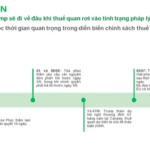
CPI’s rate of increase/decrease in May 2025 compared to the previous month. Source: Statistics Office
|
Specifically, in the 0.16% increase in CPI in May 2025 compared to the previous month, there were 10 groups of goods and services with increasing price indices, while the price index of the transportation group decreased.
The ten groups of goods and services with increasing price indices include:
– Housing, utilities, fuel, and construction materials increased by 0.73% (impacting a 0.14 percentage point increase in overall CPI), mainly due to price increases in certain items: Maintenance materials for housing rose by 1.20%; rental prices went up by 0.64%; electricity prices increased by 0.84%; and water prices rose by 1.0%. On the contrary, kerosene prices dropped by 3.09% due to adjustments made during the month.
– The “other goods and services” group increased by 0.43%, mainly driven by increases in certain items: Jewelry rose by 10.64% following domestic and global gold price movements; body care products increased by 0.52%; bags, suitcases, and wallets went up by 0.48%; watch and jewelry repair rose by 0.40%; and ceremonial services increased by 0.17%.
– Culture, entertainment, and tourism rose by 0.28%. Specifically, package tours increased by 1.09% (domestic tourism rose by 1.24%, and international tourism rose by 0.67%) due to high demand during the holiday period and the upcoming summer peak season; hotels increased by 1.36%; guesthouses rose by 0.50%; sports venue rental prices increased by 0.51%; and sports equipment prices went up by 0.15%. Conversely, prices for potted plants and flowers decreased by 1.61%, and musical instruments dropped by 0.02%.
– The postal and telecommunications group increased by 0.21%. Mobile phone prices rose across the board: ordinary mobile phones increased by 0.68%; smart mobile phone and tablet accessories went up by 0.51%; smart mobile phones and tablets rose by 0.28%; and phone repair services increased by 0.31% due to increased demand for technology devices during promotional campaigns. Additionally, labor costs and replacement part prices also increased.
– The household equipment and appliances group increased by 0.19%. Repairs for washing machines rose by 0.64%; air conditioner repairs increased by 0.40%; and refrigerator repairs went up by 0.37% as the weather transitioned to the hot season, leading to higher maintenance service and replacement part costs. Hot water flask prices increased by 0.48%; bath soap, shower gel, and shampoo prices all rose by 0.45%; plastic items went up by 0.39%; and electric fans increased by 0.36%.
– Beverages and tobacco increased by 0.14% due to rising production costs and consumer demand. Carbonated soft drinks rose by 0.49%; bottled, canned, or boxed energy drinks increased by 0.17%. Cigarette and beer prices also went up by 0.18% and 0.10%, respectively, compared to the previous month.
– Clothing, hats, and footwear increased by 0.05%. Shoe services rose by 0.40%; hats, raincoats, and umbrellas increased by 0.52%; tailoring services went up by 0.33%; fabric prices rose by 0.12%; and other clothing items such as gloves and socks rose by 0.04%.
– Food and catering services increased by 0.03%, with a breakdown as follows: Cereals decreased by 0.18%; food products dropped by 0.04%; and dining out increased by 0.28%.
– Medicine and healthcare services rose by 0.02%, mainly driven by a 0.25% increase in the prices of medical devices such as cold compresses, blood pressure monitors, and medical cotton/bandages due to rising production costs and increased healthcare demands. Painkillers, anti-inflammatory drugs, and treatments for gout and bone diseases increased by 0.18%; anti-allergy and hypersensitivity medications rose by 0.15%; and respiratory drugs went up by 0.11%.
– Education increased marginally by 0.01%, with stationery prices rising by 0.12%: Writing instruments increased by 0.24%; other stationery and school supplies went up by 0.17%; and paper products rose by 0.11%.
The transportation group was the only one to witness a decrease, falling by 0.42%, mainly due to a 2.33% drop in diesel prices and a 1.20% decrease in gasoline prices following adjustments in domestic fuel prices in line with global trends. Conversely, some items within the group saw price increases: Vehicle maintenance rose by 0.36%; water passenger transport increased by 0.89%; bus passenger transport went up by 0.22%; road passenger transport rose by 0.16%; car washing and pumping services increased by 0.24%; and spare parts prices rose by 0.25%.
Core inflation in May 2025 increased by 0.33% compared to the previous month and by 3.33% compared to the same period last year. For the first five months of 2025, core inflation averaged a 3.10% increase compared to the same period last year, lower than the 3.21% increase in overall CPI. This was mainly due to the impact of food, electricity, and healthcare services, which are included in the CPI calculation but excluded from the core inflation basket.
– 09:10 06/06/2025
Mr. Tran Hoang Son (VPBankS): The Market Prepares for the September – October Wave
In May, the VN-Index reached a high of nearly 1,348 points and several Fibonacci resistance levels. As such, it’s not surprising to see some corrective sessions in early June. Should a pullback opportunity present itself in mid or late June, medium-term investors can consider entering the market to position themselves for the potential wave in September-October.
The Fed is in a Bind: Walking the Tightrope of Interest Rates
From the beginning of the year to mid-April 2025, the average lending interest rates for new transactions of commercial banks decreased by 0.6 percentage points compared to the end of 2024. This move has provided a much-needed respite for businesses by alleviating the pressure of capital costs in production and trading activities, thereby fostering economic growth.
“Investors Lose Hundreds of Millions in a Matter of Days: The Risky Business of Gold”
“Once considered a ‘safe haven’, gold is now a volatile asset. In today’s ever-changing economic landscape, the value of gold is subject to rapid fluctuations, making it an uncertain investment choice. With global markets in a constant state of flux, investors are seeking more stable havens for their wealth.”





















